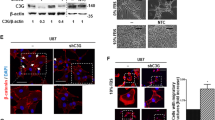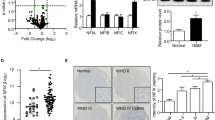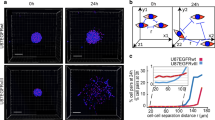Abstract
Glioblastoma multiforme (GBM) is the most frequent and aggressive primary brain tumors in adults. Uncontrolled proliferation and abnormal cell migration are two prominent spatially and temporally disassociated characteristics of GBMs. In this study, we investigated the role of the receptor tyrosine kinase EphB2 in controlling the proliferation/migration dichotomy of GBM. We studied EphB2 gain of function and loss of function in glioblastoma-derived stem-like neurospheres, whose in vivo growth pattern closely replicates human GBM. EphB2 expression stimulated GBM neurosphere cell migration and invasion, and inhibited neurosphere cell proliferation in vitro. In parallel, EphB2 silencing increased tumor cell proliferation and decreased tumor cell migration. EphB2 was found to increase tumor cell invasion in vivo using an internally controlled dual-fluorescent xenograft model. Xenografts derived from EphB2-overexpressing GBM neurospheres also showed decreased cellular proliferation. The non-receptor tyrosine kinase focal adhesion kinase (FAK) was found to be co-associated with and highly activated by EphB2 expression, and FAK activation facilitated focal adhesion formation, cytoskeleton structure change and cell migration in EphB2-expressing GBM neurosphere cells. Taken together, our findings indicate that EphB2 has pro-invasive and anti-proliferative actions in GBM stem-like neurospheres mediated, in part, by interactions between EphB2 receptors and FAK. These novel findings suggest that tumor cell invasion can be therapeutically targeted by inhibiting EphB2 signaling, and that optimal antitumor responses to EphB2 targeting may require concurrent use of anti-proliferative agents.
This is a preview of subscription content, access via your institution
Access options
Subscribe to this journal
Receive 50 print issues and online access
$259.00 per year
only $5.18 per issue
Buy this article
- Purchase on Springer Link
- Instant access to full article PDF
Prices may be subject to local taxes which are calculated during checkout






Similar content being viewed by others
References
Quick A, Patel D, Hadziahmetovic M, Chakravarti A, Mehta M . Current therapeutic paradigms in glioblastoma. Rev Recent Clin Trials 2010; 5: 14–27.
Giese A, Bjerkvig R, Berens ME, Westphal M . Cost of migration: invasion of malignant gliomas and implications for treatment. J Clin Oncol 2003; 21: 1624–1636.
Giese A, Loo MA, Tran N, Haskett D, Coons SW, Berens ME . Dichotomy of astrocytoma migration and proliferation. Int J Cancer 1996; 67: 275–282.
Rahman R, Smith S, Rahman C, Grundy R . Antiangiogenic therapy and mechanisms of tumor resistance in malignant glioma. J Oncol 2010; 2010: 251231.
Candolfi M, Curtin JF, Nichols WS, Muhammad AG, King GD, Pluhar GE et al. Intracranial glioblastoma models in preclinical neuro-oncology: neuropathological characterization and tumor progression. J Neurooncol 2007; 85: 133–148.
Lee J, Kotliarova S, Kotliarov Y, Li A, Su Q, Donin NM et al. Tumor stem cells derived from glioblastomas cultured in bFGF and EGF more closely mirror the phenotype and genotype of primary tumors than do serum-cultured cell lines. Cancer Cell 2006; 9: 391–403.
Ying M, Wang S, Sang Y, Sun P, Lal B, Goodwin CR et al. Regulation of glioblastoma stem cells by retinoic acid: role for Notch pathway inhibition. Oncogene 2011; 30: 3454–3467.
Pasquale EB . Eph–ephrin bidirectional signaling in physiology and disease. Cell 2008; 133: 38–52.
Pasquale EB . Eph receptors and ephrins in cancer: bidirectional signalling and beyond. Nat Rev Cancer 2010; 10: 165–180.
Arvanitis D, Davy A . Eph/ephrin signaling: networks. Genes Dev 2008; 22: 416–429.
Noren NK, Pasquale EB . Paradoxes of the EphB4 receptor in cancer. Cancer Res 2007; 67: 3994–3997.
Batlle E, Bacani J, Begthel H, Jonkheer S, Gregorieff A, van de Born M et al. EphB receptor activity suppresses colorectal cancer progression. Nature 2005; 435: 1126–1130.
Conover JC, Doetsch F, Garcia-Verdugo JM, Gale NW, Yancopoulos GD, Alvarez-Buylla A . Disruption of Eph/ephrin signaling affects migration and proliferation in the adult subventricular zone. Nat Neurosci 2000; 3: 1091–1097.
Cortina C, Palomo-Ponce S, Iglesias M, Fernandez-Masip JL, Vivancos A, Whissell G et al. EphB–ephrin-B interactions suppress colorectal cancer progression by compartmentalizing tumor cells. Nat Genet 2007; 39: 1376–1383.
Noren NK, Foos G, Hauser CA, Pasquale EB . The EphB4 receptor suppresses breast cancer cell tumorigenicity through an Abl–Crk pathway. Nat Cell Biol 2006; 8: 815–825.
Chiu ST, Chang KJ, Ting CH, Shen HC, Li H, Hsieh FJ . Overexpression of EphB3 enhances cell–cell contacts and suppresses tumor growth in HT-29 human colon cancer cells. Carcinogenesis 2009; 30: 1475–1486.
Noblitt LW, Bangari DS, Shukla S, Knapp DW, Mohammed S, Kinch MS et al. Decreased tumorigenic potential of EphA2-overexpressing breast cancer cells following treatment with adenoviral vectors that express ephrinA1. Cancer Gene Ther 2004; 11: 757–766.
Fox BP, Kandpal RP . Invasiveness of breast carcinoma cells and transcript profile: Eph receptors and ephrin ligands as molecular markers of potential diagnostic and prognostic application. Biochem Biophys Res Commun 2004; 318: 882–892.
Fukai J, Yokote H, Yamanaka R, Arao T, Nishio K, Itakura T . EphA4 promotes cell proliferation and migration through a novel EphA4–FGFR1 signaling pathway in the human glioma U251 cell line. Mol Cancer Ther 2008; 7: 2768–2778.
Kuijper S, Turner CJ, Adams RH . Regulation of angiogenesis by Eph–ephrin interactions. Trends Cardiovasc Med 2007; 17: 145–151.
Surawska H, Ma PC, Salgia R . The role of ephrins and Eph receptors in cancer. Cytokine Growth Factor Rev 2004; 15: 419–433.
Brantley-Sieders DM, Zhuang G, Hicks D, Fang WB, Hwang Y, Cates JM et al. The receptor tyrosine kinase EphA2 promotes mammary adenocarcinoma tumorigenesis and metastatic progression in mice by amplifying ErbB2 signaling. J Clin Invest 2008; 118: 64–78.
Larsen AB, Pedersen MW, Stockhausen MT, Grandal MV, van Deurs B, Poulsen HS . Activation of the EGFR gene target EphA2 inhibits epidermal growth factor-induced cancer cell motility. Mol Cancer Res 2007; 5: 283–293.
Vaught D, Chen J, Brantley-Sieders DM . Regulation of mammary gland branching morphogenesis by EphA2 receptor tyrosine kinase. Mol Biol Cell 2009; 20: 2572–2581.
Lugli A, Spichtin H, Maurer R, Mirlacher M, Kiefer J, Huusko P et al. EphB2 expression across 138 human tumor types in a tissue microarray: high levels of expression in gastrointestinal cancers. Clin Cancer Res 2005; 11: 6450–6458.
Alazzouzi H, Davalos V, Kokko A, Domingo E, Woerner SM, Wilson AJ et al. Mechanisms of inactivation of the receptor tyrosine kinase EPHB2 in colorectal tumors. Cancer Res 2005; 65: 10170–10173.
Huusko P, Ponciano-Jackson D, Wolf M, Kiefer JA, Azorsa DO, Tuzmen S et al. Nonsense-mediated decay microarray analysis identifies mutations of EPHB2 in human prostate cancer. Nat Genet 2004; 36: 979–983.
Lee HS, Nishanian TG, Mood K, Bong YS, Daar IO . EphrinB1 controls cell–cell junctions through the Par polarity complex. Nat Cell Biol 2008; 10: 979–986.
Bar EE, Chaudhry A, Lin A, Fan X, Schreck K, Matsui W et al. Cyclopamine-mediated hedgehog pathway inhibition depletes stem-like cancer cells in glioblastoma. Stem Cells 2007; 25: 2524–2533.
Fan X, Khaki L, Zhu TS, Soules ME, Talsma CE, Gul N et al. NOTCH pathway blockade depletes CD133-positive glioblastoma cells and inhibits growth of tumor neurospheres and xenografts. Stem Cells 2010; 28: 5–16.
Sun P, Xia S, Lal B, Eberhart CG, Quinones-Hinojosa A, Maciaczyk J et al. DNER, an epigenetically modulated gene, regulates glioblastoma-derived neurosphere cell differentiation and tumor propagation. Stem Cells 2009; 27: 1473–1486.
Ying M, Sang Y, Li Y, Guerrero-Cazares H, Quinones-Hinojosa A, Vescovi AL et al. KLF9, a differentiation-associated transcription factor, suppresses Notch1 signaling and inhibits glioblastoma-initiating stem cells. Stem Cells 2010; 29: 20–31.
Nakada M, Niska JA, Miyamori H, McDonough WS, Wu J, Sato H et al. The phosphorylation of EphB2 receptor regulates migration and invasion of human glioma cells. Cancer Res 2004; 64: 3179–3185.
Kumar SR, Scehnet JS, Ley EJ, Singh J, Krasnoperov V, Liu R et al. Preferential induction of EphB4 over EphB2 and its implication in colorectal cancer progression. Cancer Res 2009; 69: 3736–3745.
Miao H, Li DQ, Mukherjee A, Guo H, Petty A, Cutter J et al. EphA2 mediates ligand-dependent inhibition and ligand-independent promotion of cell migration and invasion via a reciprocal regulatory loop with Akt. Cancer Cell 2009; 16: 9–20.
Pollard SM, Yoshikawa K, Clarke ID, Danovi D, Stricker S, Russell R et al. Glioma stem cell lines expanded in adherent culture have tumor-specific phenotypes and are suitable for chemical and genetic screens. Cell Stem Cell 2009; 4: 568–580.
Heese O, Disko A, Zirkel D, Westphal M, Lamszus K . Neural stem cell migration toward gliomas in vitro. Neuro Oncol 2005; 7: 476–484.
Genander M, Halford MM, Xu NJ, Eriksson M, Yu Z, Qiu Z et al. Dissociation of EphB2 signaling pathways mediating progenitor cell proliferation and tumor suppression. Cell 2009; 139: 679–692.
Holmberg J, Genander M, Halford MM, Anneren C, Sondell M, Chumley MJ et al. EphB receptors coordinate migration and proliferation in the intestinal stem cell niche. Cell 2006; 125: 1151–1163.
Sarkaria JN, Carlson BL, Schroeder MA, Grogan P, Brown PD, Giannini C et al. Use of an orthotopic xenograft model for assessing the effect of epidermal growth factor receptor amplification on glioblastoma radiation response. Clin Cancer Res 2006; 12: 2264–2271.
Brantley-Sieders DM, Caughron J, Hicks D, Pozzi A, Ruiz JC, Chen J . EphA2 receptor tyrosine kinase regulates endothelial cell migration and vascular assembly through phosphoinositide 3-kinase-mediated Rac1 GTPase activation. J Cell Sci 2004; 117: 2037–2049.
Slack-Davis JK, Martin KH, Tilghman RW, Iwanicki M, Ung EJ, Autry C et al. Cellular characterization of a novel focal adhesion kinase inhibitor. J Biol Chem 2007; 282: 14845–14852.
Golubovskaya VM, Nyberg C, Zheng M, Kweh F, Magis A, Ostrov D et al. A small molecule inhibitor, 1,2,4,5-benzenetetraamine tetrahydrochloride, targeting the y397 site of focal adhesion kinase decreases tumor growth. J Med Chem 2008; 51: 7405–7416.
Walker EH, Pacold ME, Perisic O, Stephens L, Hawkins PT, Wymann MP et al. Structural determinants of phosphoinositide 3-kinase inhibition by wortmannin, LY294002, quercetin, myricetin, and staurosporine. Mol Cell 2000; 6: 909–919.
Nakada M, Niska JA, Tran NL, McDonough WS, Berens ME . EphB2/R-Ras signaling regulates glioma cell adhesion, growth, and invasion. Am J Pathol 2005; 167: 565–576.
Galli R, Binda E, Orfanelli U, Cipelletti B, Gritti A, De Vitis S et al. Isolation and characterization of tumorigenic, stem-like neural precursors from human glioblastoma. Cancer Res 2004; 64: 7011–7021.
Hoelzinger DB, Mariani L, Weis J, Woyke T, Berens TJ, McDonough WS et al. Gene expression profile of glioblastoma multiforme invasive phenotype points to new therapeutic targets. Neoplasia 2005; 7: 7–16.
Nakada M, Anderson EM, Demuth T, Nakada S, Reavie LB, Drake KL et al. The phosphorylation of ephrin-B2 ligand promotes glioma cell migration and invasion. Int J Cancer 2010; 126: 1155–1165.
Madhavan S, Zenklusen JC, Kotliarov Y, Sahni H, Fine HA, Buetow K . Rembrandt: helping personalized medicine become a reality through integrative translational research. Mol Cancer Res 2009; 7: 157–167.
Reznik TE, Sang Y, Ma Y, Abounader R, Rosen EM, Xia S et al. Transcription-dependent epidermal growth factor receptor activation by hepatocyte growth factor. Mol Cancer Res 2008; 6: 139–150.
Taddei ML, Parri M, Angelucci A, Onnis B, Bianchini F, Giannoni E et al. Kinase-dependent and -independent roles of EphA2 in the regulation of prostate cancer invasion and metastasis. Am J Pathol 2009; 174: 1492–1503.
Chatzizacharias NA, Kouraklis GP, Theocharis SE . Clinical significance of FAK expression in human neoplasia. Histol Histopathol 2008; 23: 629–650.
Cox BD, Natarajan M, Stettner MR, Gladson CL . New concepts regarding focal adhesion kinase promotion of cell migration and proliferation. J Cell Biochem 2006; 99: 35–52.
Frisch SM, Vuori K, Ruoslahti E, Chan-Hui PY . Control of adhesion-dependent cell survival by focal adhesion kinase. J Cell Biol 1996; 134: 793–799.
van Nimwegen MJ, van de Water B . Focal adhesion kinase: a potential target in cancer therapy. Biochem Pharmacol 2007; 73: 597–609.
Shi Y, Pontrello CG, DeFea KA, Reichardt LF, Ethell IM . Focal adhesion kinase acts downstream of EphB receptors to maintain mature dendritic spines by regulating cofilin activity. J Neurosci 2009; 29: 8129–8142.
Luo M, Guan JL . Focal adhesion kinase: a prominent determinant in breast cancer initiation, progression and metastasis. Cancer Lett 2010; 289: 127–139.
Schwock J, Dhani N, Hedley DW . Targeting focal adhesion kinase signaling in tumor growth and metastasis. Expert Opin Ther Targets 2010; 14: 77–94.
Zhao J, Guan JL . Signal transduction by focal adhesion kinase in cancer. Cancer Metastasis Rev 2009; 28: 35–49.
Garber K . Of Ephs and ephrins: companies target guidance molecules in cancer. J Natl Cancer Inst 2010; 102: 1692–1694.
Pfaffl MW . A new mathematical model for relative quantification in real-time RT-PCR. Nucleic Acids Res 2001; 29: e45.
Goodwin CR, Lal B, Zhou X, Ho S, Xia S, Taeger A et al. Cyr61 mediates hepatocyte growth factor-dependent tumor cell growth, migration, and Akt activation. Cancer Res 2010; 70: 2932–2941.
Lal B, Xia S, Abounader R, Laterra J . Targeting the c-Met pathway potentiates glioblastoma responses to gamma-radiation. Clin Cancer Res 2005; 11: 4479–4486.
Acknowledgements
This work was supported by the Maryland Stem Cell Research Fund (MSCRFE) 2009-0126-00 (SX), NIH NS43987 (JL) and the James S McDonnell Foundation (JL). We thank Dr Hugo Guerrero-Cázares for technical advice and Miss Mir Shanaz Hossain for technical assistance. We also thank Mr Hao Zhang from Johns Hopkins School of Public Health for assistance with flow cytometric analysis.
Author contributions: SDW: Collection and assembly of data, data analysis and interpretation, final approval; PR, BL, J-PR, YL, CRG: Collection and assembly of data, final approval; JL: Financial support, administrative support, data analysis and interpretation, manuscript writing, final approval. SX: Conception and design, financial support, administrative support, collection and assembly of data, data analysis and interpretation, manuscript writing, final approval.
Author information
Authors and Affiliations
Corresponding author
Ethics declarations
Competing interests
The authors declare no conflict of interest.
Additional information
Supplementary Information accompanies the paper on the Oncogene website
Rights and permissions
About this article
Cite this article
Wang, S., Rath, P., Lal, B. et al. EphB2 receptor controls proliferation/migration dichotomy of glioblastoma by interacting with focal adhesion kinase. Oncogene 31, 5132–5143 (2012). https://doi.org/10.1038/onc.2012.16
Received:
Revised:
Accepted:
Published:
Issue Date:
DOI: https://doi.org/10.1038/onc.2012.16
Keywords
This article is cited by
-
Eph receptors and ephrins in cancer progression
Nature Reviews Cancer (2024)
-
The sialyl-Tn antigen synthase genes regulates migration–proliferation dichotomy in prostate cancer cells under hypoxia
Glycoconjugate Journal (2023)
-
DHODH inhibition impedes glioma stem cell proliferation, induces DNA damage, and prolongs survival in orthotopic glioblastoma xenografts
Oncogene (2022)
-
Activation of neural lineage networks and ARHGEF2 in enzalutamide-resistant and neuroendocrine prostate cancer and association with patient outcomes
Communications Medicine (2022)
-
The Impact of Phenotypic Heterogeneity on Chemotactic Self-Organisation
Bulletin of Mathematical Biology (2022)



